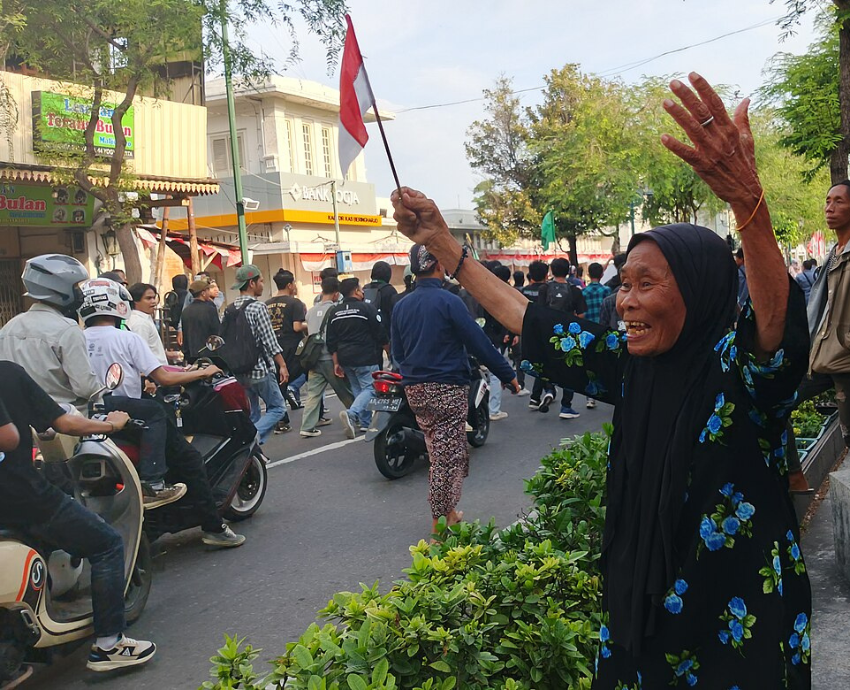
Nationally coordinated demonstrations of Indonesian workers took place on August 28 in major urban centres in Java, Sumatra and Sulawesi. Police responses were marked by sweeps, beatings of demonstrators and journalists and the killing of a 21-year-old motorbike taxi rider who was run over by an armoured police vehicle.
These events became the trigger for simultaneous demonstrations in at least 37 towns and cities across the archipelago on August 29–30. At the time of writing, there have been actions in 107 cities in 32 provinces since August 25.
The government and political observers have expressed shock at the mass scale of these simultaneous political actions that, in the words of President Prabowo Subianto, were completely unanticipated.
Yet, for many activists across the country, this moment became a national point of convergence for many localised political campaigns that have been more or less ongoing since 2015. These campaigns have included responding to local and regional issues of land rights and environmental protection, and many of them emerged as a result of the government’s national strategic project drive.
Growing dissatisfaction
From late July, the Jolly Roger Straw Hat Pirate flag, featured in the Japanese anime series One Piece, began to appear in public places across the country, on the back of trucks or hoisted on poles in local kampongs (villages).
While the flag was not tied to particular political demands or demonstrations, it was recognised as an expression of widespread popular disappointment with central and regional governments, whose policies marginalise the needs and concerns of ordinary citizens. Hoisting the flag represented a political stance without the risk of police violence associated with organising or joining large-scale street actions.
This dissatisfaction stems from citizens struggling to survive in the face of a widespread cost-of-living crisis, large-scale job losses in the formal sector and new laws and policies that bring rising levels of uncertainty around democratic rights and economic security for the mass of precarious poor people in rural and urban areas.
The central government’s drive to maximise state revenues through tax reform at every level, since the second period of the Joko Widodo (Jokowi) government, is now being replicated at a regional level, as the central government pushes for districts to develop new revenue streams and reduce dependency on national budgets.
The new central government’s budget efficiency drive has left district governments with limited operational revenue since the beginning of this year — a gap that many district governments responded to by hiking land taxes — by as much as 200–1000% in the 2025 financial year.
Protests sparked
In early August, these district land tax hikes in Central Java drew national attention, when residents in Pati district mobilised to oppose a 250% land tax hike.
Local responses were swift and dramatic as about 50,000 residents took to the streets on August 13, demanding the sacking of the district head and the revoking of the tax hike.
These actions were organised after the district head made public statements that he didn’t care if 5000 or 50,000 residents protested the new tax payments; they would not be revoked.
While he subsequently revoked the hikes and made a formal apology to the people of Pati, the demonstrations calling for his resignation remain ongoing.
Similar demonstrations took place in Bone district in South Sulawesi and Cirebon city in West Java.
Many proposed tax hikes in other districts have now been reviewed or withdrawn, after government officials observed the potential for rapid popular mobilisations.
In the week prior to August 29, local and regional actions took place in Java, Sulawesi, Kalimantan and Sumatra, with demands for Indigenous land rights and environmental protections against rapidly expanding nickel mining and deforestation, and for liveable wages and humane working conditions.
Since early this year, several major manufacturing and retail company closures have precipitated major job losses, with little alternative employment available in the formal sector. Earlier this year, national news outlets reported that 10 million young people with freshly minted bachelor’s degrees were unable to find professional jobs and were seeking work in door-to-door sales, selling food from home and even street sweeping.
To add insult to injury, wage rises and new housing allowances for national parliamentarians were announced in the days prior to the most recent demonstrations, triggering widespread anger and resentment.
While minimum wages vary across the country, estimates are that officials’ salaries can be as much as 40 to 140 times the minimum wage paid to workers in the formal sector. For those working precariously in the informal sector, most cannot scrape together even a minimum wage income each month.
Repression and violence
The state’s response to these demonstrations at the national level has been to intensify repression, through direct violence against protesters, surveillance and doxing of those identified as field coordinators, random sweeps against young people on streets near demonstration sites and large-scale arrests.
More than 1000 people were arrested in Jakarta and Semarang combined, with comparatively large-scale arrests in other cities and towns. The military has been deployed to “safeguard” national and district parliaments, town squares and places where demonstrations are usually held, while riot police armed with tear gas and rubber bullets have been deployed to respond to demonstrations.
In Central Java, a provincial education department directive closed primary and junior high schools over September 1–3, while senior high school students had to attend school. Prabowo, while expressing his condolences for those killed in the mass demonstrations, affirmed that those responsible for protest actions could be charged with treason and terrorism.
In light of these developments, many local organising groups have suspended immediate plans for demonstrations while continuing to organise and consolidate their networks and defence for those arrested and activists targeted through doxing and surveillance.
While it is uncertain what will take place in the coming days and weeks, activists at the grassroots level are building new links with ordinary people in towns and villages who are angered by the government’s arrogance and disrespect for ordinary people’s demands for a secure livelihood and the right to free expression.
[Rebecca Meckelburg is a research fellow at the Institute for International Studies, Universitas Gadjah Mada and the Indo-Pacific research centre at Murdoch University.]
